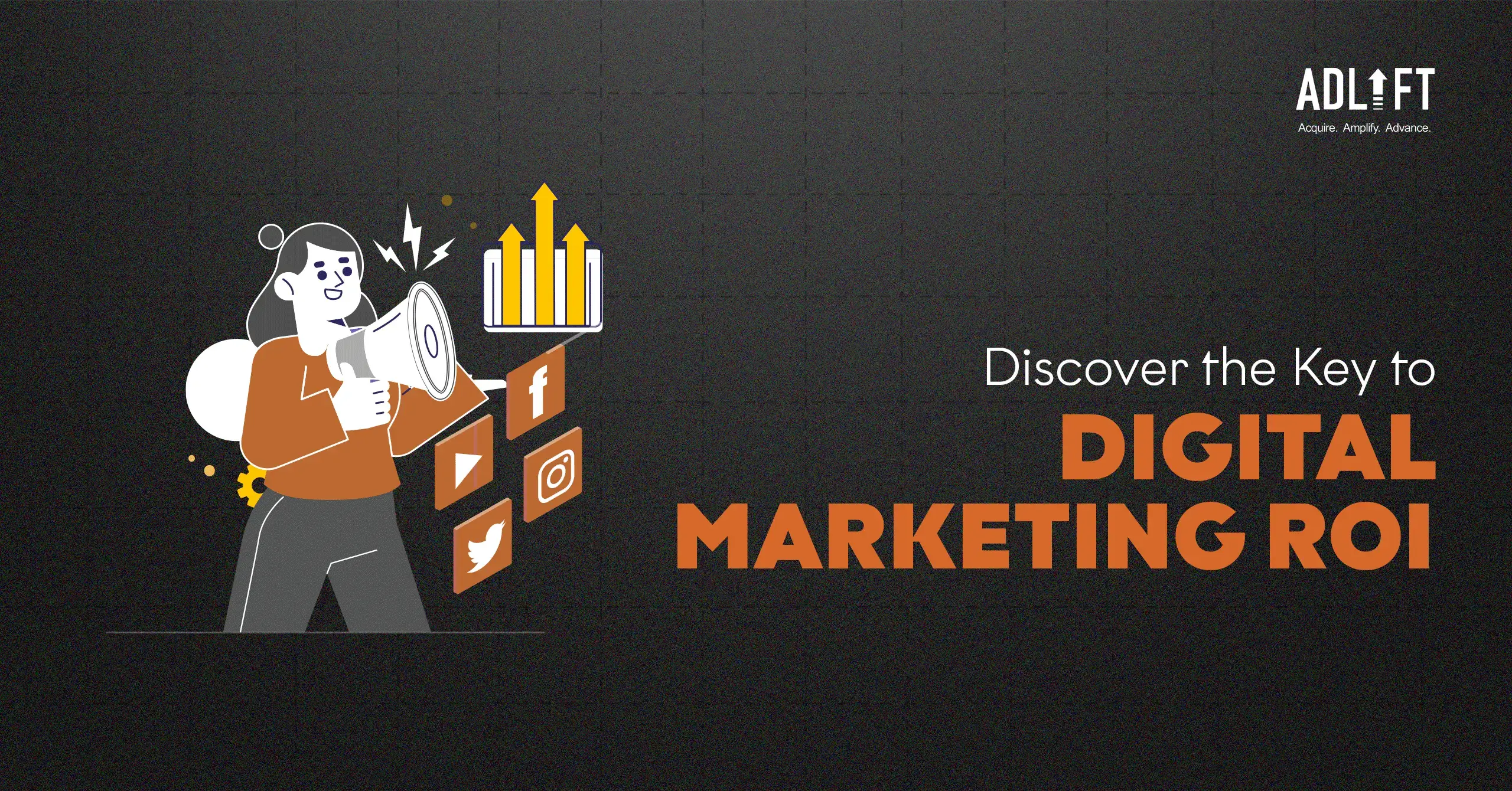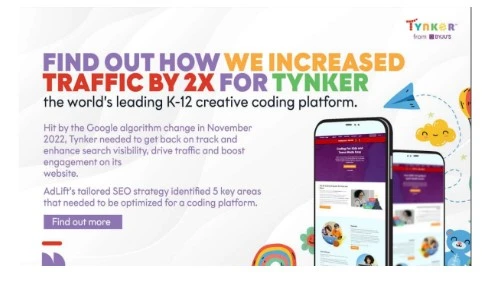The AdLift Guide to ROI-Centric Digital Marketing

Did you know that 72% of organizations that measure ROI on digital marketing report their marketing strategies as effective? This statistic highlights the critical need for precise measurement of digital marketing return on investment. Today, companies allocate substantial budgets to online marketing strategies, aiming to capture and engage their target audiences across various digital platforms. However, these investments can easily go untracked without a clear understanding of ROI, leading to missed opportunities and wasted resources.
Recognizing the importance of ROI on digital marketing decisions allows businesses to refine their strategies, allocate budgets more effectively, and ultimately achieve better outcomes. By diligently measuring ROI, companies can ensure that their digital marketing efforts reach their intended audiences and drive meaningful, measurable results that contribute to their overall success.
What is ROI-Centric Digital Marketing?
ROI-centric digital marketing is a data-driven approach that emphasizes measuring and optimizing digital marketing campaigns to achieve the highest possible return on investment. By carefully tracking performance metrics and analyzing the data, businesses can identify which strategies yield the best results and allocate resources more effectively. This approach helps maximize the financial returns from marketing efforts and ensures that every penny spent contributes to the overall business goals. Through continuous monitoring and fine-tuning of campaigns, ROI online marketing enables organizations to make informed decisions, enhance customer engagement, and drive sustainable growth.
Challenges in Measuring ROI on Digital Marketing
Accurately measuring ROI in the digital marketing domain presents unique challenges, particularly on social media and content marketing platforms. These platforms generate vast amounts of data from various interactions, making it difficult to isolate the impact of specific campaigns. With its blend of paid advertisements, organic reach, and influencer collaborations, social media complicates the tracking of direct conversions and the true value of customer engagement.
Get
in Touch
Contact AdLift for a 360-degree marketing plan
Similarly, content marketing, which focuses on creating valuable, long-term relationships with audiences, often lacks immediate, measurable outcomes, making it challenging to link content efforts directly to revenue. These complexities necessitate advanced tracking tools and advanced attribution models to clearly understand and improve marketing ROI. Some of the major challenges are listed below.
- Fragmented Data Sources: Digital marketing data is often spread across multiple platforms, such as social media, email marketing, and web analytics tools. This fragmentation makes consolidating data into a single, cohesive view challenging, leading to incomplete or inaccurate ROI calculations. Businesses must invest in robust data integration solutions to overcome this hurdle and achieve a unified data perspective.
- Lack of Clear Goals: Without clearly defined goals, it becomes nearly impossible to measure success accurately. Many businesses struggle to establish specific, measurable objectives for their digital marketing campaigns, complicating tracking progress and calculating performance marketing ROI. Setting clear, achievable goals is essential for effective performance measurement and strategic decision-making.
- Difficulty in Attributing Conversions: Attribution is the process of determining which marketing activities are responsible for driving conversions. In a multi-channel digital environment, attributing conversions to specific touchpoints can be highly complex. This difficulty often leads to inaccurate ROI assessments, as businesses may undervalue or overvalue certain marketing channels. Utilizing advanced attribution models can help in accurately assigning credit and understanding the true impact of each marketing effort.
Benefits of ROI-centric Digital Marketing
Best ROI digital marketing offers numerous benefits that can significantly enhance a business’s overall performance and efficiency. By focusing on measuring and optimizing the return on investment, businesses can make data-driven decisions that improve budget allocation, campaign performance, lead generation, and sales.
- Improved Budget Allocation: By accurately measuring digital advertising ROI, businesses can identify which marketing activities yield the highest returns and allocate their budgets more effectively. This ensures that resources are directed toward the most profitable campaigns, reducing waste and enhancing overall marketing efficiency.
- Better Campaign Performance: Continuous monitoring and optimization of campaigns based on ROI data enable businesses to fine-tune their strategies for maximum impact. This data-driven approach helps identify successful tactics and scale them while also addressing underperforming areas, leading to overall better campaign performance.
- Increased Lead Generation: An ROI-centric approach allows businesses to focus on strategies that generate the highest quality leads. By understanding which channels and content drive the most engagement and conversions, businesses can enhance their lead generation efforts, resulting in a higher quantity and quality of potential customers.
- Higher Sales: Ultimately, the goal of any marketing effort is to drive sales. By optimizing campaigns for ROI, businesses can ensure that their marketing activities directly contribute to revenue growth. This approach increases sales and improves the marketing investments’ overall profitability, leading to sustainable business growth.
Developing Your ROI-Centric Digital Marketing Framework
If you are thinking of how to improve ROI in digital marketing, then developing a robust ROI-centric framework is essential. It involves implementing several strategic components to ensure accurate measurement and optimization of marketing efforts. Here are key strategies to consider:
- Define Clear Objectives: The foundation of an effective ROI-centric framework begins with setting clear, specific, and measurable objectives. These goals should align with overall business objectives and provide a clear direction for marketing activities. Defining objectives helps create targeted campaigns and allows for precise measurement of success. For instance, whether the aim is to increase website traffic by 20% or to generate 500 new leads per month, clear objectives provide a benchmark against which ROI can be calculated.
- Implement Advanced Analytics: Utilizing advanced analytics tools is crucial for gathering and analyzing data from various digital marketing channels. These tools enable businesses to track key performance indicators (KPIs), monitor user behavior, and gain insights into campaign effectiveness. Advanced analytics helps identify trends, understand customer preferences, and make data-driven decisions. Platforms like Google Analytics, Adobe Analytics, and specialized marketing analytics tools offer detailed reports that are essential for evaluating ROI on digital marketing.
- Utilize Conversion Tracking: Conversion tracking is essential for measuring the effectiveness of marketing efforts in driving desired actions, such as purchases, sign-ups, or downloads. By setting up conversion tracking, businesses can monitor the customer journey from initial contact to final action, providing insights into which campaigns and channels are most effective. This tracking can be implemented through tools like Google Ads, Facebook Pixel, or CRM systems, ensuring that every marketing activity’s impact on conversions is accurately recorded and analyzed.
- Embrace Attribution Modeling: Attribution modeling identifies which marketing touchpoints contribute to conversions and how much credit each touchpoint deserves. This strategy helps businesses understand the customer journey across multiple channels and interactions. By embracing advanced attribution models, such as linear, time decay, or data-driven attribution, businesses can understand which marketing efforts drive ROI in digital marketing. This understanding allows for better resource allocation and optimization of marketing tactics.
- Focus on Lifetime Value: Focusing on customers’ lifetime value (LTV) helps businesses understand the long-term profitability of their marketing efforts. LTV considers the total revenue a customer generates over their entire relationship with the business rather than just the initial sale. By calculating and optimizing for LTV, businesses can make more informed decisions about customer acquisition costs and retention strategies. This long-term perspective ensures that marketing investments are evaluated for immediate returns and sustained profitability and growth.
How to Measure ROI in Digital Marketing?
Measuring ROI on digital marketing involves evaluating the profitability of marketing campaigns by comparing the revenue generated from these campaigns against the costs incurred.
Calculate ROI: Use the formula for ROI on digital marketing to determine the profitability of the campaign.
ROI=(Net Profit/ Total Cost)×100
Example:
- Total Campaign Cost: ₹50,000
- Revenue Generated from Campaign: ₹1,50,000
- Net Profit= Revenue Generated−Total Campaign Cost
- Net Profit= ₹1,50,000 − ₹50,000 = ₹1,00,000
- ROI = (₹1,00,000/50,000) *100 = 200%
- Interpretation: An ROI on digital marketing of 200% means that for every ₹1 spent on the campaign, an additional ₹2 was earned in profit. In other words, the campaign generated twice the profit compared to the cost.
Implementing Your ROI-Centric Strategy
Implementing an ROI-centric strategy in digital marketing involves various approaches to maximize returns on investment. Here’s an elaboration on each strategy mentioned:
Data-Driven Decision Making
Using data to guide marketing strategies and decisions rather than relying on intuition or assumptions.
Implementation:
- Collect Relevant Data: Use tools like Google Analytics, social media insights, CRM systems, and ad platforms to gather data on customer behavior, campaign performance, and market trends.
- Analyze Performance Metrics: Focus on key performance indicators (KPIs) such as click-through rates (CTR), conversion rates, customer acquisition cost (CAC), and lifetime value (LTV).
- A/B Testing: Conduct experiments to compare different campaign or website element versions to see which performs better.
- Real-Time Monitoring: Continuously monitor campaign performance and make adjustments as necessary to optimize results.
Benefits:
- More accurate targeting
- Improved campaign effectiveness
- Reduced wasteful spending
Personalization
Tailoring marketing messages and experiences to individual consumers based on their preferences, behavior, and demographics.
Implementation:
- Segment Your Audience: Divide your customer base into smaller groups based on age, gender, location, purchase history, and behavior.
- Personalized Content: Create personalized email campaigns, product recommendations, and targeted ads that resonate with each segment.
- Dynamic Website Content: Use tools that change website content based on the visitor’s profile or behavior.
- Behavioral Targeting: Use data on user behavior to tailor ads and content to individuals at different stages of the customer journey.
Benefits:
- Increased engagement
- Higher conversion rates
- Better customer loyalty
Conversion Optimization
Enhancing your website and marketing efforts to increase the percentage of visitors who complete desired actions (conversions), such as purchasing or signing up for a newsletter.
Implementation:
- User Experience (UX) Improvements: Optimize site navigation, load times, and mobile responsiveness.
- Clear Calls-to-Action (CTAs): Ensure CTAs are prominent, clear, and compelling.
- Landing Page Optimization: Design landing pages with a specific focus and minimal distractions to drive conversions.
- Reduce Friction: Simplify the conversion process by minimizing form fields, providing multiple payment options, and offering guest checkout.
- Retargeting: Use retargeting ads to bring back visitors who didn’t convert on their first visit.
Benefits:
- Higher sales
- Improved ROI
- Better user satisfaction
Competitive Analysis
Assessing your competitors’ strengths and weaknesses to gain insights and identify opportunities to outperform them.
Implementation:
- Identify Competitors: List your direct and indirect competitors in the market.
- Analyze Their Strategies: Study their marketing tactics, ad campaigns, content strategies, and customer engagement methods.
- Benchmarking: Compare your performance metrics with your competitors to identify gaps and opportunities.
- SWOT Analysis: Evaluate their strengths, weaknesses, opportunities, and threats to inform your own strategy.
- Monitor Changes: Observe competitors’ new campaigns, product launches, and market positioning.
Benefits:
- Better strategic planning
- Identification of market opportunities
- Enhanced competitive edge
Mobile Marketing
Reaching and engaging customers through mobile devices, given the increasing use of smartphones and tablets.
Implementation:
- Responsive Design: Ensure your website and emails are mobile-friendly, providing a seamless experience across all devices.
- Mobile Apps: Develop a mobile app to directly engage customers and offer personalized experiences.
- SMS Marketing: Use SMS campaigns to deliver timely offers, reminders, and updates.
- Location-Based Marketing: Utilize GPS data to deliver personalized messages and offers to customers based on their location.
- Mobile Ads: Invest in mobile advertising on platforms like Google Ads and social media to reach users on their devices.
Benefits:
- Greater reach
- Enhanced user engagement
- Higher conversion rates from mobile users
Case Study: As Tynker’s SEO and Content Marketing agency, we implemented a robust strategy that not only increased the brand’s leads but also reduced its customer acquisition cost. You can read the full case study here:

Leveraging Effective ROI Strategies
Implementing the best ROI digital marketing strategies is crucial for businesses thriving in the digital world. If you are still confused about how to increase marketing ROI, we at AdLift can come to your rescue. We optimize campaign performance by measuring ROI on digital marketing efforts, ensuring that every dollar invested yields maximum returns. This approach enables us to allocate budgets to the most effective strategies, leveraging data-driven insights to fine-tune our marketing initiatives continuously.
Categories
- AI
- ChatGPT
- Content Marketing
- Content Marketing & Strategy
- Digital Marketing
- Entrepreneurship
- Google Analytics
- Google Tag Manager
- Google Updates
- Influencer Marketing
- Mobile App Marketing
- Paid Marketing
- Press
- Pubcon
- Search Engine Marketing
- Search Engine Optimization
- SEO
- SEO Tools
- Social Media Marketing
Recent Posts
- How do I Verify My Business on Google to Ace Local SEO? March 17, 2025
- The Pros and Cons of Pay For Performance SEO March 17, 2025
- Website Structure for SEO: A Blueprint for Better Rankings March 17, 2025
- Keyword Cannibalization: Why It Matters for Your Company and How to Avoid It March 12, 2025
- SEO for Bing: Unlocking Opportunities for Business Owners and Marketers March 11, 2025
- Google Cached Websites: A Quick Guide to Accessing Them March 5, 2025
- Programmatic Advertising: Stop Just Talking About It, and Start Driving Real Growth (A Business Leader’s Guide to Cutting Through the Hype) March 4, 2025
- How to Use Google Trends: The Ultimate Guide for SEO & Content Marketers March 4, 2025
- Farewell, Skype: It’s the End of an Era March 3, 2025
- How to Plan and Execute a Website Migration Without Losing Rankings? February 28, 2025




